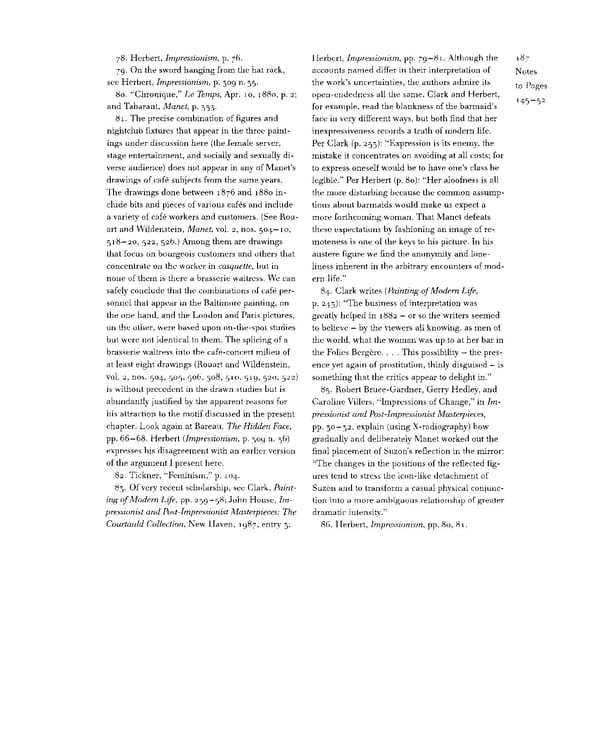78. Herbert, Impressionism, p. 76. Herbert, Impressionism, pp. 79 — 81. Although the i87 79. On the sword hanging from the hat rack, accounts named differ in their interpretation of Notes see Herbert, Impressionism, p. 309 n.35. the work's uncertainties, the authors admire its to Pages 80. "Chronique," Le Temps, Apr. 10, 1880, p. 2; open-endedness all the same. Clark and Herbert, 145-52 and Tabarant, Manet, p. 333. for example, read the blankness of the barmaid's 81. The precise combination of figures and face in very different ways, but both find that her nightclub fixtures that appear in the three paint- inexpressiveness records a truth of modern life. ings under discussion here (the female server, Per Clark (p. 253): "Expression is its enemy, the stage entertainment, and socially and sexually di- mistake it concentrates on avoiding at all costs; for verse audience) does not appear in any of Manet's to express oneself would be to have one's class be drawings of cafe subjects from the same years. legible." Per Herbert (p. 80): "Her aloofness is all The drawings done between 1876 and 1880 in- the more disturbing because the common assump- clude bits and pieces of various cafes and include tions about barmaids would make us expect a a variety of cafe workers and customers. (See Rou- more forthcoming woman. That Manet defeats art and Wildenstein, Manet, vol. 2, nos. 504-10, these expectations by fashioning an image of re- 518—20, 522, 526.) Among them are drawings moteness is one of the keys to his picture. In his that focus on bourgeois customers and others that austere figure we find the anonymity and lone- concentrate on the worker in casquette, but in liness inherent in the arbitrary encounters of mod- none of them is there a brasserie waitress. We can ern life." safely conclude that the combinations of cafe per- 84. Clark writes (Painting of Modern Life, sonnel that appear in the Baltimore painting, on p. 243): "The business of interpretation was the one hand, and the London and Paris pictures, greatly helped in 1882 — or so the writers seemed on the other, were based upon on-the-spot studies to believe — by the viewers all knowing, as men of but were not identical to them. The splicing of a the world, what the woman was up to at her bar in brasserie waitress into the cafe-concert milieu of the Folies Bergere. . . . This possibility — the pres- at least eight drawings (Rouart and Wildenstein, ence yet again of prostitution, thinly disguised — is vol. 2, nos. 504, 505, 506, 508, 510, 519, 520, 522) something that the critics appear to delight in." is without precedent in the drawn studies but is 85. Robert Bruce-Gardner, Gerry Hedley, and abundantly justified by the apparent reasons for Caroline Villers, "Impressions of Change," in Im- his attraction to the motif discussed in the present pressionist and Post-Impressionist Masterpieces, chapter. Look again at Bareau, The Hidden Face, pp. 30—32, explain (using X-radiography) how pp. 66-68. Herbert (Impressionism, p. 309 n. 36) gradually and deliberately Manet worked out the expresses his disagreement with an earlier version final placement of Suzon's reflection in the mirror: of the argument I present here. "The changes in the positions of the reflected fig- 82. Tickner, "Feminism," p. 104. ures tend to stress the icon-like detachment of 83. Of very recent scholarship, see Clark, Paint- Suzon and to transform a casual physical conjunc- ing of Modern Life, pp. 239 — 58; John House, Im- tion into a more ambiguous relationship of greater pressionist and Post-Impressionist Masterpieces: The dramatic intensity." Courtauld Collection, New Haven, 1987, entry 3; 86. Herbert, Impressionism, pp. 80, 81.
 Prostitution & Impressionists Page 207 Page 209
Prostitution & Impressionists Page 207 Page 209